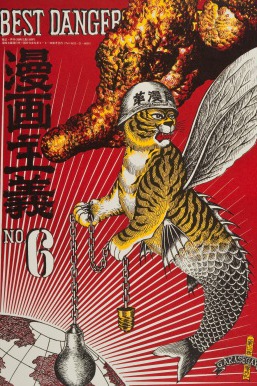10 Things in Tokyo: November Round-Up

First of all, thank you to all who came and celebrated Tokyo Art Beat’s 10th anniversary. Hundreds of Tokyo art lovers took in art and music performances at this special event. Here’s to another 10 years!
Veteran artist Kishio Suga, best known for his work with the 1960s and ’70s avant-garde group Mono-ha, is having a retrospective at The Vangi Sculpture Garden Museum in Shizuoka. Throughout his career, Suga has worked with primary materials such as stone and wood to explore objects in nature, and to bring heightened awareness to audiences of the spaces that surround them. Spanning four decades, some of these outdoor pieces have only been known through photographs until now. See and explore until March 24 next year.
Last month, many mourned the passing of another senior figure of the Japanese avant-garde, Genpei Akasagawa. Beyond his involvement with the influential avant-garde artist group Hi-Red Centre and the Neo Dada-ists, Akasegawa was a manga artist, illustrator, novelist, essayist and photographer. He gained a reputation as an icon of the anti-art movement, too, when his fake thousand-yen notes became the subject of an infamous court case. “The Artistic Theory of Genpei Akasegawa— From 1960 to Now” is at the Chiba City Museum of Art until December 23.
Festival/Tokyo is Japan’s largest theatre event and it attracts a variety of international performers and creators. One of the draw cards for this year’s festival is a radical new revision of Igor Stravinsky’s “The Rite of Spring.” Tokyo media artist Yuko Mohri, who utilizes junk and everyday objects to make elaborate sculptures and installations, is the stage designer. The production will run over 5 days, from November 12 until 16, in the Tokyo Metropolitan Theatre in Ikebukuro.
This month also offers a look at the visual arts of Russia, then and now. First, the Setagaya Art Museum has “Seeking Utopia: Russian Avant-garde and Soviet Modernism in Posters,” utilizing the collection of fashion designer Ruki Matsumoto. See works by Vassily Kandinsky, Kasimir Malevich, the Sternberg brothers and Alexander Rodchenko among others. Showing until November 24. Second, Yuka Tsuruno Gallery are showing photographs of Alexander Gronsky, known for his images of contemporary Russia. From the gallery: “Referring to himself as a landscape photographer, he focuses on vast spaces and investigates the relationship between local populations and their surrounding environment, often exploring the border regions between suburbs and cities, the personal and public space, and between living and death.”
Ligyung is a Korean artist who makes stunning light installations. The Tree of Knowledge of Good and Evil (2001) utilizes super-bright squid lights; the kind that fisherman use to lure squid toward their boats. Her works are an exploration of light’s relationship to truth and knowledge, playing with the audience’s sensory understanding of their surrounds. See her work at Maison Hermes until January 7 next year. At contemporary art gallery Arataniurano, see Yusuke Asai‘s large drawing-based creations. Often spreading across walls, floors and ceilings, Asai’s lines and colors resemble ancient cave paintings. Until December 20. At ShugoArts, this month sees a three-person show including Teppei Kaneuji, Kesang Lamdark and Lee Kit. Although coming from diverse backgrounds, and using a variety of materials, the exhibition seeks to convey the artists’ similar method in which they choose their media and wish to communicate.
Yuni Yoshida is a young and talented designer with a solo exhibition at Laforet Museum Harajuku. See her work as well as getting insight into her process through sketches and photographic documentation. From November 12 until November 24. Finally, artist group Chim↑Pom have an exhibition at SNAC / Mujin-to Production. The group get serious with themes such as the paradox of contemporary borders, be they political, social or physical. Until November 29.
Emily Wakeling
Emily Wakeling



